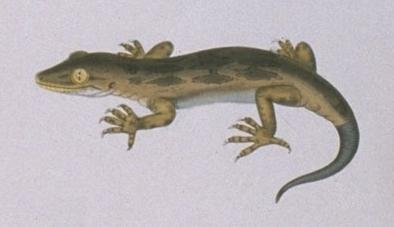- Hoplodactylus
Taxobox
name = "Hoplodactylus"

image_width = 240px
image_caption = "Hoplodactylus pacificus "
regnum =Animal ia
phylum = Chordata
classis = Reptilia
ordo =Squamata
familia =Gekkonidae
genus = "Hoplodactylus"
subdivision_ranks = Species
subdivision = "See text""Hoplodactylus" is one of two genera of geckos native to
New Zealand , the other being "Naultinus ".Species in this genus tend to have rather dull colouration with little variation on a generally brown/grey theme, although mottled greens are seen in some species, notably the forest gecko, "Hoplodactylus granulatus". The one exception to this rule of general drabness in colouration is the striking "herring boned" colour pattern of green, brown, black and white that is displayed by "Hoplodactylus rakiurae".
Although generally species of this genus cannot compete with those of "Naultinus" in terms of their vivid and beautiful colouration, "Hoplodactylus" species do have the ability to subtly change their skin colour pattern to give better
camouflage , thus reducing the risk of predation. "In some of the Hoplodactylus species, the ability to change colour provides a supplementary method of thermoregulation"(*1). When basking in cold conditions they can darken their skin to increase the amount of heat absorbed and conversely they can lighten the shades in hot weather to reflect more light and keep cool. All species in this genus have more or lessnocturnal activity patterns in contrast to the solely diurnal nature of "Naultinus" species and unlike species in the latter genus, are not purelyarboreal and will forage on the ground."Hoplodactylus" species do not have "prehensile" tails and are thus generally less reluctant to drop them when disturbed by predators than species in the "Naultinus" genus - however, there are two exceptions, the Goldstripe gecko "
Hoplodactylus chrysosireticus " and the Pacific gecko "Hoplodactylus pacificus " both have a very flighty disposition and will often shed their tails at the slightest provocation.Many species of the "Hoplodactylus" genus also have toes that are broader and more expanded than their relatives in the "Naultinus" genus.
"
Hoplodactylus duvaucelii " is the largest species of gecko remaining in New Zealand although due to predation by introducedmammal s such as theNorway rat their range is at present restricted to pest-free offshore islands.The extinct
Kawekaweau/Delcourt's gecko "Hoplodactylus delcourti" was the largest known gecko in the world. It was first described in1986 though the only known specimen was collected in the early 1800s but was overlooked in a French museum for more than a century.pecies
*
Gold-striped gecko , "Hoplodactylus chrysosireticus "
*Kawekaweau , "Hoplodactylus delcourti " (extinct)
*Duvaucel's gecko , "Hoplodactylus duvaucelii "
*Forest gecko , "Hoplodactylus granulatus "
*Black-eyed gecko , "Hoplodactylus kahutarae "
*Common gecko , "Hoplodactylus maculatus "
*Cloudy gecko , "Hoplodactylus nebulosus "
*Pacific gecko , "Hoplodactylus pacificus "
*Harlequin gecko , "Hoplodactylus rakiurae "
*Stephen's Island gecko , "Hoplodactylus stephensi "
*Takitimu gecko , "Hoplodactylus cryptozoicus "References
* "New Zealand Geckos; A guide to captive maintenance and breeding", RPV Rowlands, Ecoprint, 1999
* "New Zealand frogs and reptiles", Brian Gill and Tony Whitaker, David Bateman publishers, 1996External links
* [http://www.doc.govt.nz/templates/podcover.aspx?id=33116]
*
Wikimedia Foundation. 2010.
